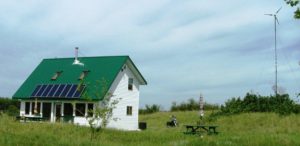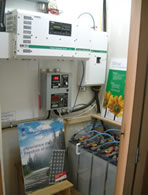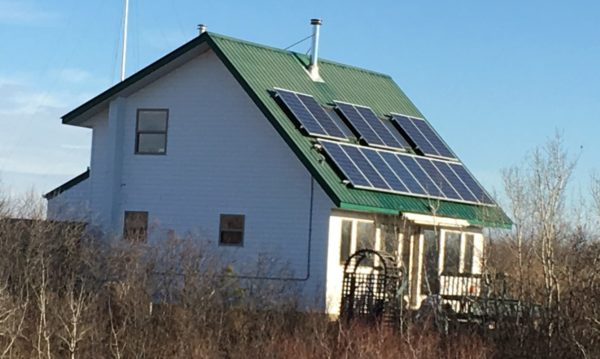Plugging it in: From Off-Grid to Grid-tied
Our Solar Home Experiment in 2003

We chose to do an off-grid system because, in those days, there were no good programs to feed power back to the utility and no incentives for installing grid-tied solar. In Saskatchewan, the solar industry was still very young and solar power was still quite expensive. Our home, built as a modest 24' x 28' ready to move (RTM) home, was our experiment in passive solar design and off-grid power.


Our solar and wind power system supplied the 5 kWh per day that we needed for our energy efficient home. An inverter converted the DC power from our solar and wind power to the normal AC power required for all the standard appliances in our home. A large battery bank stored power for overnight and cloudy days, providing backup for at least 3 days of very low power input. We used a backup generator for the short days of winter when there were long periods without enough sun and wind to keep the batteries charged. Winters can be a bit of challenge in an off-grid house.
Our Solar Home Experiment in 2016
After 13 years of off-grid living, we decided to convert from Off-grid to Grid-tied Solar. Why?
1. Seasonal Storage
Many a summer morning our batteries were full by 10:00 am. With nowhere else to store any excess sun power coming in, whatever we didn't immediately use for our house after 10:00 would be wasted. What a shame! If only we could store that for the winter! A grid-tied system on the net metering program makes that possible. Our excess solar power in the summer is now fed back to SaskPower for credit for the winter months, at the same rate that we are paying.
2. SaskPower becomes our backup
Instead of starting the generator when there is not enough solar power to keep the batteries charged, SaskPower now provides that backup. For us, this means that we no longer need our backup generator with its maintenance and fuel requirements - and noise! Generators also have a much shorter lifetime than a solar power system. It had become time to replace our current generator, an expense that was roughly equivalent in cost to bringing in grid power. We chose grid power - SaskPower is a much less expensive and more convenient backup than a generator.
3. Battery lifetime will be much longer
Battery lifetime depends on how often you cycle the battery, which happens every time you have to use power from it to run your household. With the batteries constantly being charged due to our grid-tie connection, the batteries are only cycled during a power outage when they become our backup. During a power outage, a grid-tied system must shut down automatically so that the problems with the electrical utility system can be safely repaired. However, if you have a backup battery bank like ours, you can switch to this backup during a power outage. Since this does not happen often the typical battery life of 10 - 12 years will be substantially extended. This is a big advantage since a battery bank like ours is around $10,000 to $12,000. We have already replaced our battery bank once.
4. Electric appliances replace propane
We replaced our propane appliances with electric appliances because their energy usage can be offset by solar. It also reduced our reliance on propane deliveries and fluctuating prices. To compensate for the new electric appliances - cookstove, water heater and space heater - we installed more solar panels.

What do we miss from being Off-Grid?
We miss the sense of pride in being self sufficient, which is what attracts many people to the idea of living off-grid. We also had a very clear idea of what we were using for power all the time, which was shown on a battery system monitoring display. When we started the toaster, or the water pump started up, you could see the sudden power draw from the batteries on the monitor. Once we became grid-tied this display became meaningless. Our batteries are constantly fully charged from grid power (except during a power outage).
Off-Grid Systems: Ideal for Remote Homes or Cottages

Off-grid systems can provide reliable power where utility power is not available or is very expensive to bring in. The system must be sized appropriately to meet your needs and being energy efficient is important to keep costs down. New off-grid inverters provide internet monitoring for the system and are Grid-tie ready if it becomes more feasible to connect to the utility.